Mikel Arteta’s Arsenal have reached a new stratosphere of play this season, having been in a process of development for three years since Arteta came in to take over as manager.
The overhaul has been profound, and while this progress hasn’t yet been quantified by UEFA Champions League football or a top, top end Premier League finish, this season looks set to change that. And perhaps the most impressive part of Arsenal’s season so far, is the fact that they aren’t even the finished product yet. Their average squad age is low, with key players such as Bukayo Saka, Gabriel Martinelli and William Saliba still far from their potential peaks, and star summer signing Gabriel Jesus has been injured for a significant period too.
Arsenal’s best may yet be to come, and yet, Arteta has them playing incredibly effective football.
This tactical analysis piece will be an analysis of the direct football tactics that Arteta has been using to great success at the Emirates Stadium.
What Arsenal do in games
Arsenal are known to dominate games. They are strong in possession and press aggressively out of possession. They have technical players who allow them to keep the ball – players who are also capable of high-quality incisive passes, penetrative dribbles, or deadly finishes. These players are young, fit, and hungry – they are streetwise and nip in to steal possession, just as they use brute physicality to do so in equal measure.
They are switched on in transitions – mentally focused and lightning quick on the break. When they arrive in goal-creating positions, the end result is inevitable – Arsenal seem so efficient and deadly – playing the most stylish iteration of direct football that the viewer could possibly fathom.
Arsenal set up in a nominal 4-3-3 formation, which usually features a few tweaks, as per the following visualisation.
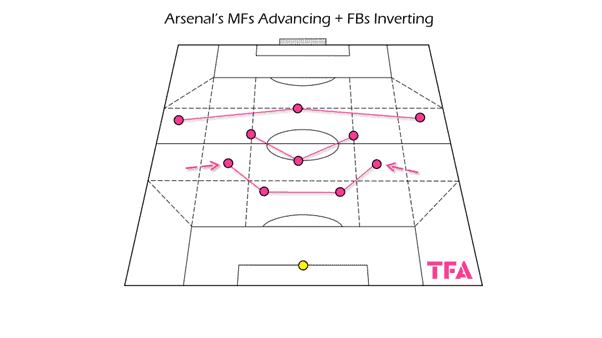
Arsenal form a 2-3 structure in the first couple of lines of the team in ball-possession. Typically, you could expect the fullbacks to push on high, with the 2-3 being made of the two centrebacks and the three central midfielders – and this happens sometimes.
But more frequently, in build-up and progression, it is one of the (or both of the) fullbacks who joins the #6 in the middle three in the 2-3. This allows one, or both, of the midfielders to push on and join what will become the front five.
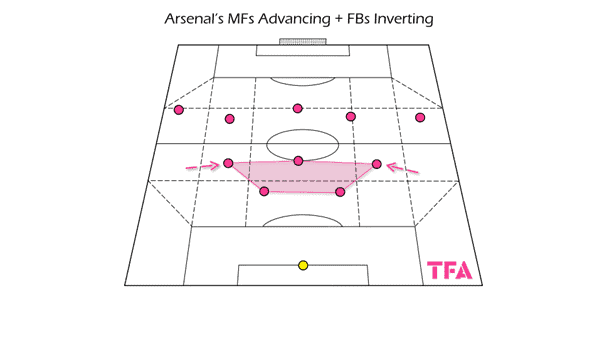
The way Arsenal’s play manifests itself certainly bears hallmarks of a positional play system – players generally occupy specific zones in order for the team to create its favoured structures. The specific players who fill these positions can differ – this is simply the nature of rotations within a fairly fluid footballing side.
What is simply important, is the fact that Arsenal consistently find themselves forming favourable structures, which gives them the framework to play their direct, high-intensity play within. This requires discipline and tactical/game IQ – both of which Arteta has instilled in his team perfectly.
Arteta is an excellent example of implementing his coached features of play – and this makes him the gold standard of coaching. The only variables are the coached facets actually being good, and the players performing within the framework; because the viewer knows Arteta has been able to get his message across.
In possession
Now that it’s been discussed what Arsenal do, let’s discuss how Arsenal dominate games within their tactical framework.
The key features of domination in games are generally keeping the ball, maximising territory, preventing dangerous defensive scenarios and creating dangerous attacking scenarios. Of course these features are subjective, and vary from team to team and coach to coach (everyone is entitled to a different opinion), but suffocating the opponent with ball possession and territory, generally leads to your side creating more than your opponent, and controlling games.
While Arsenal’s direct play and creative faculties will be discussed in the following section, their ball retention and control of games will be discussed here first. In a way this is logical, because the security offered by this ball possession and territory control facilitates Arsenal’s sharp attacking play. They establish control, and then show their attacking edge.
The most holistic aspect of Arsenal’s play that gives them control is the 2-3-5 set-up, and the security it is conducive to establishing. Having a 2-3 in build-up is generally advantageous over opponent’s defensive set-ups. It offers short passing distances between players, which means possession loss is infrequent as shorter passes are generally safer and easier to execute.
Additionally, shorter passes are harder for the opposition to interpret, but more crucially, short passes give them less time to shift and settle between balls as a defensive block. Arsenal aren’t particularly predictable as a result of this, and that makes them hard to set up against.
The 2-3 also offers a numerical superiority over opposition front lines – at least, most of the time. Barring exceptions, such as a man-oriented press, opposition blocks won’t typically commit five players to match up with Arsenal’s 2-3.
4-4-2 blocks (and similar variations thereof) are very common at present, and typically these blocks can only push the front two and the two wingers on to engage with the 2-3 of Arsenal. Arsenal will always have a spare player, and this doesn’t even account for their keeper Aaron Ramsdale, who also makes ample contributions in build-up play. Teams don’t generally want to push more players on to press Arsenal, as they’ll be left with a 5v5 at the back – and with the speed and directness of Arsenal’s attackers, this would be a high-risk strategy.
Out of possession
Ball retention isn’t limited to in-possession decision making and structural advantages but is also achieved by preventing opponents from establishing good (settled or dangerous) possession phases. Arsenal are a great team when out of possession and in defensive transitions – both, largely due to their ability to press. This ability is facilitated by both the structure, and the individuals.
The 2-3 structure helps Arsenal have a compact and well-populated rest-defence in central areas. The players are always within a close proximity to the site of ball-loss, and are therefore immediately able to counter-press to regain possession.
Furthermore, Arsenal have a very good pressing structure when out of possession in settled phases, such as from opposition goal-kicks or build-up, and they adopt an aggressive hybrid press. Arsenal’s back line pushes up high accordingly, and this minimises spaces between the lines – Arsenal are very compact vertically. This allows them to pin opponents back and suffocate them into submission.
No matter how good the pressing structures are however, no team can press so well, so consistently without suitable personnel. Fortunately for Arsenal, Arteta has great talent ID, and has constructed his team around young, hungry players who are very athletically capable. Not only this, but his players are incredibly focussed and disciplined – which allows them to counter-press so quickly after possession loss – his players are always switched on.
One understated member of the (counter) press is Martin Ødegaard. Ødegaard’s diminutive frame often sees him on the receiving end of negative bias (he doesn’t strike viewers as an aggressive presser), yet he always seems to manage to nip in and regain the ball when opponents are looking to break. Ødegaard is an absolute gem of a midfielder, and his off the ball activity matches up with his world class creativity on the ball.
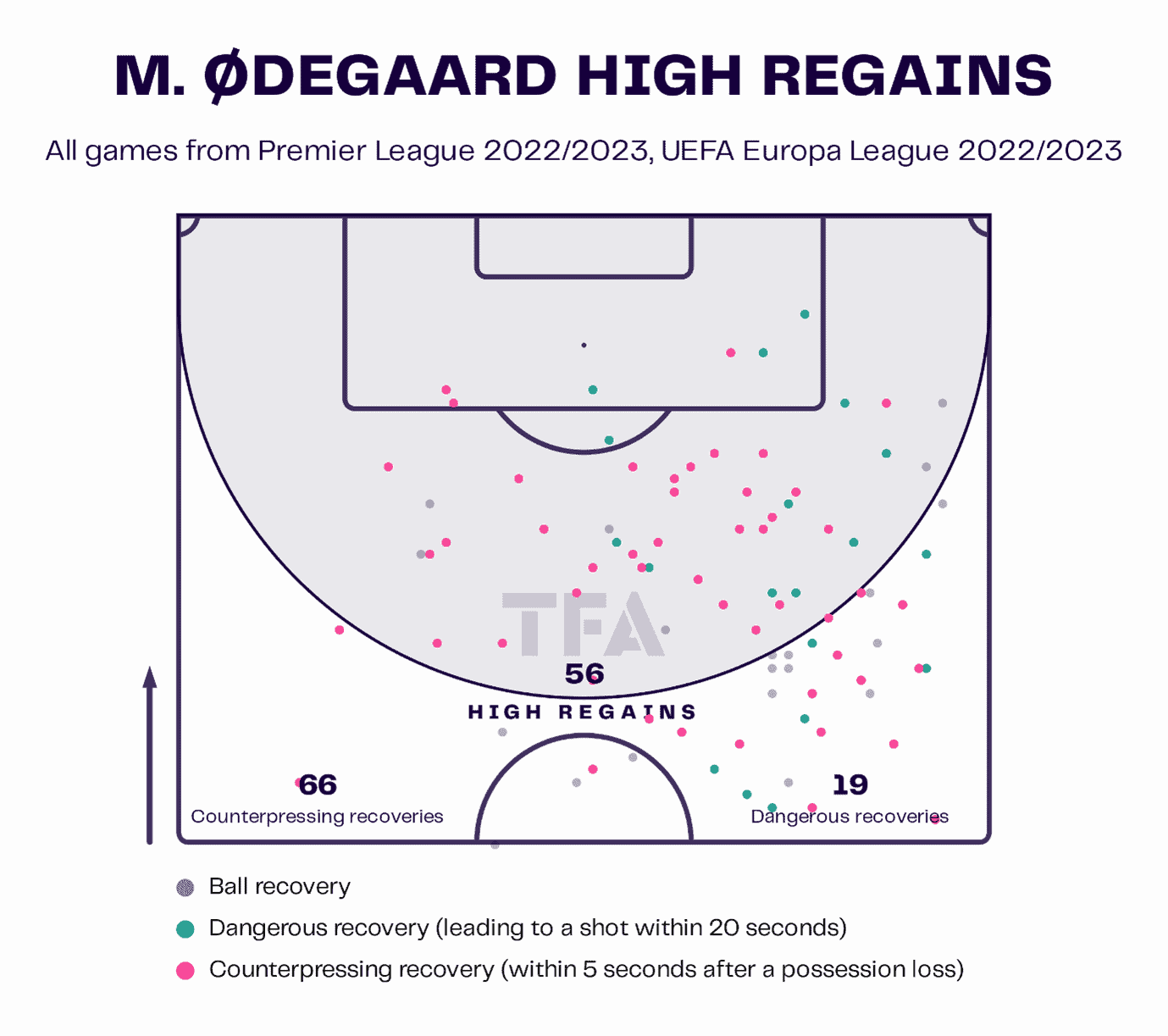
Arsenal dominate the ball with high ball retention, and smart in-possession decisions, within their positional framework – and they dominate territory by pushing teams back with relentless pressure. This is all brilliant and effective, but an incisive cutting-edge is also needed to become a top team. Fortunately for Arsenal, Mikel Arteta has also implemented this, through his coached principles, and the dynamic superiorities his team often establish.
How Arsenal create & infiltrate
A dynamic superiority is a form of advantage that a team can form. It is usually similar to a positional superiority, in terms of the advantage is a player reaching a specific advantageous position, but in the case of dynamic superiorities, the player arrives in the dangerous space before the opponents. This can be done through third man runs, or well-timed runs for example.
The key feature of Arteta’s Arsenal, in progression and chance creation, is that their players are always in movement, and always seem to be arriving on dangerous situations ahead of their defenders. There are a number of coached mechanisms from Arteta, that induce these favourable dynamic scenarios.
Arteta’s use of a non-vertical pitch shape, both idealistically, and in training (between games), helps to instil a certain positional mindset into players. Players aren’t encouraged to stand in the same vertical plane as each other, because if a simple pass were to be made in this scenario, the receiver wouldn’t be able to receive ‘in movement’.
The infamous clip of Arteta explaining why it’s important for Bukayo Saka (the right winger) to be moving inside as Ben White (the right back) carries the ball wide is a perfect microcosm for the types of movement Arsenal players need to be in when receiving the ball, to achieve a dynamic superiority, and arrive in dangerous spaces before their opponents.
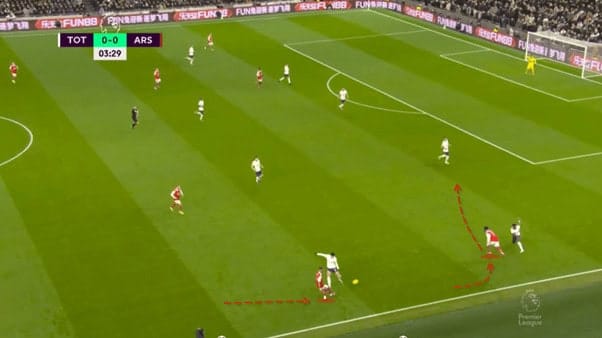
Bukayo Saka receiving in movement from a Ben White Pass – by positioning themselves ideally to create a dynamic superiority.
Arsenal’s team structure is also conducive to creating dynamic superiorities. With the midfielders able to push on in the half-spaces, because the fullbacks invert, Arsenal are able to sustainably create third-man scenarios – particularly on the left wing.
In a specific instance, the left back (Zinchenko), can play into the midfielder (Xhaka), who will attract defensive attention towards the half-space, and then can play out to the left-winger (Martinelli) who will be able to attack space immediately upon receiving. If Martinelli is at an advantage at a result of this, then the move is defined as a dynamic superiority.
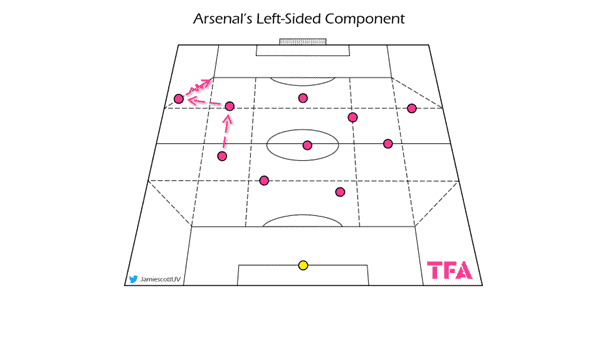
As a result of player rotations, it could well end up as Zinchenko as the player receiving at the advantage down the left. Against Manchester United, Trossard’s introduction at left wing saw him drive in the central space after receiving from Xhaka, committing the defenders, creating the dynamic superiority on the left, for Zinchenko to be able to execute a free cross from.
The beauty of the rotations means all players (within reason) can be the ones to be the third man, and this is hard for defensive teams to set up against – it isn’t predictable, and it is highly incisive from an attacking perspective. The directness of Martinelli in particular, who drives from wide to inside, is of note. Arsenal are ruthlessly efficient and are a creation juggernaut when arriving in these situations.
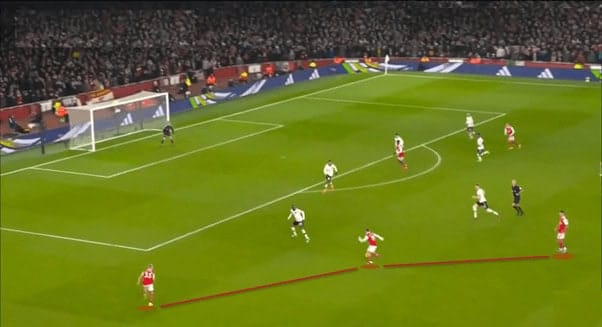
Furthermore, Arsenal are very direct in ball progression too. They aren’t afraid to play longer balls to progress or switch play, when the situation dictates. While they aren’t typically an automatism-heavy side, much of their direct play is similarly efficient to an automatism system – at least visually. When combination play occurs, players always receive in useful body orientations, which allow them to execute their action and facilitate the next action occurring at optimal angles.
An example to add colour to this notion could be a progressive pass into the #8, who is orientated to lay off a wall pass to the #6, who will make a quick switch to an onrushing fullback on the left. The fullback arriving in movement, attacking space with their first touch, ahead of their respective defenders, is another example of a dynamic superiority.
Arsenal are direct, precise, and incisive, yet stylish and sophisticated in equal measure. Their framework isn’t automatism-based, yet gives rise to dynamic superiorities with an almost unparalleled consistency.
Conclusion
Mikel Arteta has undoubtedly made Arsenal a top side again, but the method by which he has done so has less of a consensus opinion from viewers and analysts alike.
Early comparisons to Pep Guardiola have cooled down, as time has gone on since Arteta’s appointment in 2020, and the diversification in playing style since then too. Arteta doesn’t use what could be described as a static positional play system, although he does instruct his players to fill up specific positions and zones in relation to each other, in the 2-3-5 or 2-2-6 structures in ball-possession.
The focus of Arteta’s game, once control is established over an opponent, is to go for the kill – to be ruthlessly efficient and direct in creating and putting away chances. Arsenal aren’t afraid to be direct in their play, zipping the ball through the thirds to access attacking areas, however the fact that players are always arriving in these attacking areas with dynamic superiorities is crucial.
From the systematic aspects such as the structures Arsenal consistently form, to individual instructions such as body orientation or micro-movements, Mikel Arteta has ingrained tactical principles that are conducive to consistent dynamic superiorities. What this means, is that Arsenal are always attacking space, always on the front foot, and always infiltrating opposition defensive blocks.
Positional play is one thing, but this style of play strikes more as what could be called ‘Spatial Play’.






Comments